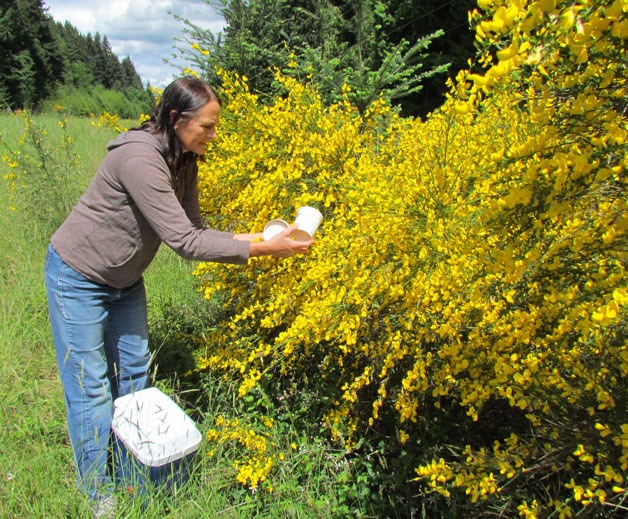RECORD STAFF
When Janet Stein hears people talk about the lovely yellow flowering shrubs along the roadsides these days, she knows she’s got a lot more educating to do.
As the Island County noxious weed coordinator, Stein is presently at war against Scotch broom.
“It may look pretty, but the negative impact it can have on the landscape is far from pretty,” she said.
Although many people know that the plant is called Scotch or Scot’s broom (Cytisus scoparius), not everyone knows that the plant is classified as a noxious weed and was quarantined by the state Department of Agriculture, Stein said.
“This means that it is not to be sold or planted by anyone and it should be removed when found growing on your property.”
Stein warns that if left alone, Scotch broom can take over a landscape, displacing native and beneficial plants.
“Standing in a patch of Scotch broom in the late summer one can hear the popping sound as the seeds are ejected like little missiles from the drying seed pods,” she said, adding that one plant can produce over 10,000 seeds per year and the seeds can stay viable in the soil for up to 50 years, sprouting when the soil is disturbed and starting a whole new generation.
Although the task seems daunting as one drives by the yellow fields and roadsides of Whidbey, it may be possible to at least slow and eventually stop the spread of this prolific invader.
Stein wryly rules out using the Army Reserves, but cites as useful a couple of little beetles named Exapion fuscirostre and Bruchidius villosus.
The adult females, which are about the size of a grain of rice, lay their eggs inside the plant’s seed pod, where the larvae hatch and consume the seeds over a period of a few weeks. “Every seed damaged by a beetle is one less future Scotch broom plant and they seem to be doing a pretty good job,” Stein said.
Last summer seed pods were collected from 10 locations on Whidbey Island and Camano Island and sent to the WSU research center for examination. All sites had at least some seeds that were damaged by one or both species of beetle and at some sites the attack rate was greater than 70 percent.
Last month, additional Scotch broom beetles were released at new locations on Whidbey and monitoring will continue to see how the bugs are dispersing and what impact they make.
“The use of insects for managing Scotch broom is an example of biological control,” Stein said, explaining that biological controls go through rigorous testing to ensure they won’t attack native or crop species.
Just don’t look for the yellow to disappear. “The beetles will never totally eradicate the Scotch broom and will take several years to make an impact,” Stein said.
“Most noxious weeds are best dealt with using an integrated pest management technique that combines mechanical, cultural, chemical, and biological controls when available. Scotch broom may be the only weed that had a tool specifically designed for helping with its mechanical removal,” she added.
Called a weed wrench, it is a solid steel tool that grabs the base of the stem and by pulling down a large level arm removes the plant, root and all. Some Scotch broom plants may be too big to effectively dig or pull. In this case the plant can be cut at ground level and the stump painted with an herbicide such as triclopyr.
In areas where large infestations of Scotch broom are removed, Stein said it is important to mulch or reseed the bare ground areas to help compete with broom seedlings.
“Unless it can be done numerous times, mowing is not usually an effective method of controlling Scotch broom because the plant will likely resprout and develop into a brushier more vigorous plant,” she added.
As is the case with most noxious weeds, control takes multiple years and has to be a community effort. Island County has an Adopt-A-Road program where individuals or organized groups can remove noxious weeds along selected sections of county road right-of-ways, similar to the roadside litter removal programs. In addition, the Island County Noxious Weed Control Board will lend out weed wrenches to individuals that want to get rid of Scotch broom on their own properties and noxious weeds can be disposed of for free at the Coupeville transfer station.
“So although the insects are doing their part, they need your help,” Stein said. “Now is the time to go to work on broom, before the seeds start popping.”
Contact Stein for additional information on Scotch broom or other noxious weeds at 360-678-7992 or jstein@wsu.edu.


